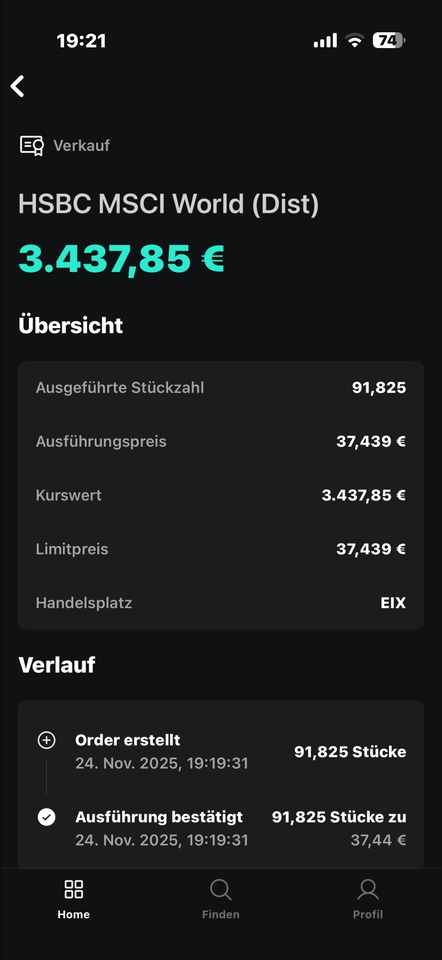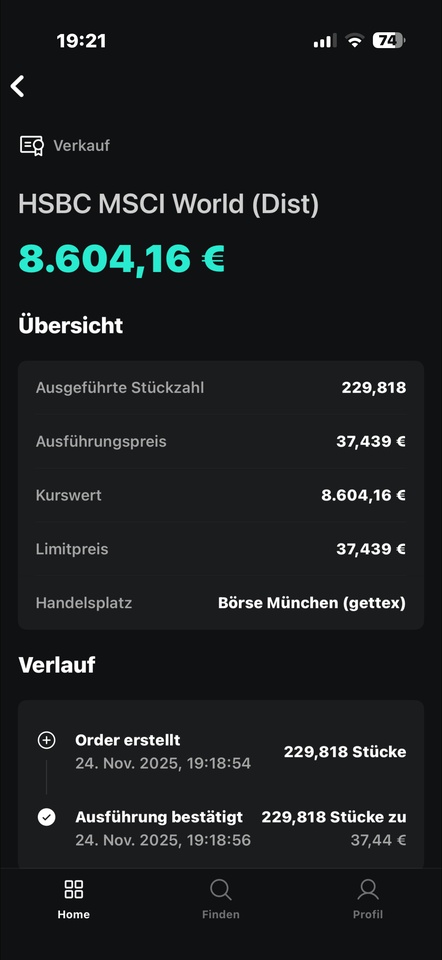
HSBC MSCI World ETF
Price
Debate sobre HMWO
Puestos
123II Simple questions to which Gemini has no answer or is lying
One question is aimed at Austrians and has to do with taxes (2.) and the other question is aimed at Trading View users 🫶 (1.).
Dear traders, I have been looking for hours for a decent indicator that graphically displays COT data as a chart. Unfortunately, my search has been unsuccessful so far. Can you recommend a specific indicator?
Let's assume I have an ETF position with a non-taxable broker abroad. This could be Scalable or Finanzen Zero, for example, and I would now like to transfer the ETF to Flatex Austria. Theoretically, the profits would then be taxable as it is a transfer from abroad. So far so good, but what does it look like in practice? Will the tax be deducted automatically or will the transfer still be carried out as normal and I will then be responsible for the tax transactions? This would open up a number of scenarios. One would be that, depending on the timing, I could enjoy a 1-year tax deferral or simply forget about it. 🤭 Who has ever done a custody account transfer like this and how does it work in practice? Specifically, it's about $VUSA (+0,23 %) and $HMWO (+0,06 %)
Why the heck does he have Coverd Call ETFs in his portfolio? TL:tr
🛡️ My "3-pillar portfolio": cash flow as an interest shield before 2028
Hello community,
Since there are controversial discussions under every post about CC ETfs
-> here are my reasons why I have them in my portfolio (and yes I have ki in the conversation)
At the age of 43, I am not only concerned with growth, but above all with risk management - because my real estate interest commitment expires on 30.09.2028, with a remaining debt of € 147,000.
My goal is to set up the portfolio in such a way that I can either offset the refinancing costs or pay off the debt completely.
1. the logic: cash flow meets growth
My investments are divided into three pillars with a clear function:
The cash flow engine
$JEPQ (+1,01 %) & $JEGP (-0,43 %) /JEPI
Generation of high monthly income (option premiums)
The growth cores
$HMWO (+0,06 %) (MSCI World) & $VUSA (+0,23 %) (S&P 500)
Long-term build-up of capital and substance
2. the strategy:
Two phases for the JPM cash flow (approx. 450 € net/month)
I use the high monthly net income from JEPQ/JEPI flexibly in two phases to achieve my goals:
🟢 Phase 1: Accumulation (Currently until approx. 2027)
* Measure: The monthly JPM distributions are reinvested directly into the VUSA ETF.
* Purpose: Utilize interest rate arbitrage (pay 1.88% interest, generate 8-10% gross return) to accelerate growth capital. The reinvestments are expected to increase the VUSA portfolio by over € 30,000 by the reporting date!
* In addition: The HMWO will continue to be built up separately with its own savings rate.
🔴 Phase 2: The interest shield (from 2028)
* Measure:
Reinvestment ends. The JPM cash flow is used to offset the increased monthly burden of the follow-up financing.
* Result: Even with a pessimistic 5.0% interest rate, the additional monthly burden of approx. +€227 is more than doubly compensated by the JPM cash flow (approx. €450 net).
Growth in VUSA and HMWO can continue.
3. the ultimate flexibility in October 2028
Thanks to the deposit cushion of an estimated € 259,000 built up over the next few years, I can choose freely on the refinancing date:
* Option A (Further growth): finance € 147,000 at the then applicable interest rates and subsidize the higher rate with the JPM cash flow. The entire growth deposit is retained.
* Option B (debt-free): Partially liquidate the deposit and pay off the €147,000 remaining debt in full. The property would be debt-free and my rental income of €520 would be pure surplus.
4. the tax advantage
Since all my ETFs (JEPQ, JEPG, VUSA, HMWO) receive the 30% partial exemption for equity funds, there is no tax disadvantage for the high-yield JPM funds compared to the growth stocks.
In addition, the rising interest costs of the property can be offset against the total income for tax purposes as income-related expenses from 2028.
Conclusion: I deliberately trade maximum capital growth in strong bull markets for financial security and compensation with a calculable real estate debt risk.
The JPM ETFs are
my active "interest rate buffer". -> we'll see if that works out
@Koenigmidas -> we've already had this conversation on another channel😅
I don't understand the point. Almost every normal ETF yields more. 🤷🏼♂️
BREAKING : President Trump announced an economic and trade agreement between the USA 🇺🇸 and CHINA🇨🇳
$CSPX (+0,16 %)
$IWDA (+0,25 %)
$EIMI (+0,5 %)
$CSNDX (+0,44 %)
$VUSA (+0,23 %)
$VHYL (+0,12 %)
$SPYI (+0,14 %)
$HMWO (+0,06 %)
President Trump announced an economic and trade agreement between the USA and China:
- China suspends all retaliatory tariffs and non-tariff measures imposed since March 4
- China issues new general licenses for the export of rare earths and suspends new export controls.
- China pledges to stop the flow of fentanyl to the US
- China will buy at least 12 million tons of US soybeans
- The USA reduces tariffs on Chinese goods by 10 percentage points
The biggest de-escalation in relations between the US and China since the start of the trade war.
China 🇨🇳 will suspend all retaliatory tariffs and non-tariff measures in place since March 4, lift export controls on rare earths, issue global licenses for rare earths and critical minerals such as gallium and graphite, and commit to buying 12 million tons of US soybeans this year and 25 million tons annually through 2028. China will also take "significant measures" to stop fentanyl shipments to the US.
In return, the U.S. 🇺🇸 will reduce tariffs on Chinese imports imposed to curb fentanyl trade by 10 percentage points of the cumulative tariff rate, effective November 10, 2025, extend Section 301 tariff exemptions through November 2026, and suspend new export control measures for one year.
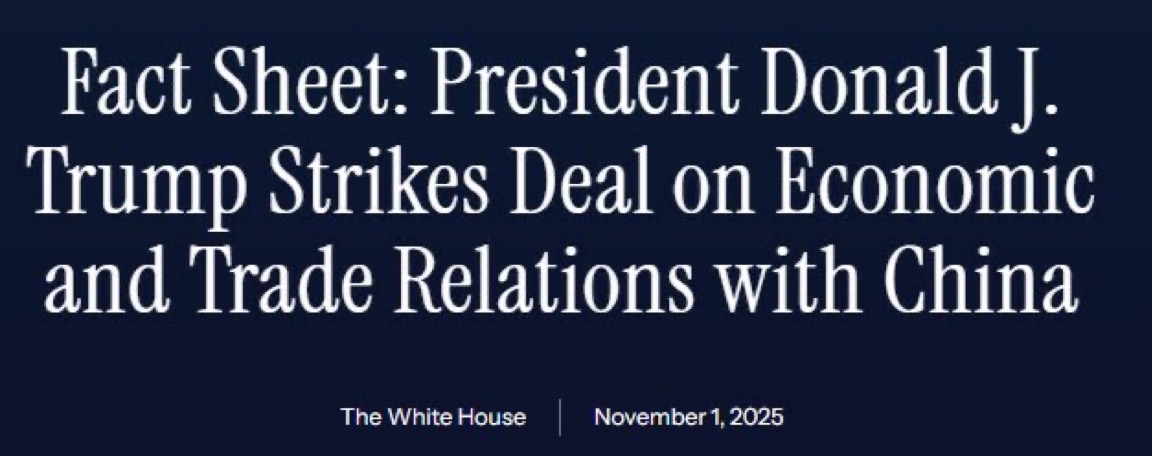
My path on the stock market: Trying out your own approach
After a lot of back and forth, I found my way.
The last few years on the stock market have been a learning and growth process for me. Of course, this process is far from complete, but I am now at the beginning of my own path and am ready to continue on it consistently.
It wasn't always like this.
I tried a lot of things on the stock market, sometimes dividend shares, then quality shares or strategies à la Finanzfluss and Co. but none of it was really mine.
So in the end, through trial and error, I came up with my own approach: my 3-pillar model, which I would like to briefly introduce here.
- The 1st pillar - long-term buy & hold
This pillar consists of long-term positions that I never sell.
Currently, these are my world and US ETFs and Bitcoin. Gold and a dividend ETF will probably be added in the coming years.
- The 2nd pillar - momentum and growth
This is about selected stocks with a focus on growth and momentum.
I trade actively and will try to take out my net investment (and possibly some profit) as often as possible.
Example: With a price gain of around 138%, I can sell 50% at the Austrian tax rate and have the net investment back out again.
German investors can already be happy at around 133% (I have not included the tax-free amount here).
I then let the remaining profit continue passively over the long term.
- The 3rd pillar - trading
The third pillar consists of short-term trading, mainly on a daily and weekly basis.
How it all works together
Profits from the second and third pillars currently flow partly into the first pillar and partly remain to strengthen the respective pillar.
Over time, the proportion that goes into the first pillar will increase.
This creates a small leverage effect, if you like, on my ETF savings plan.
My goals and risk appetite
My overriding goal is to achieve financial independence before the age of 50. Ideally, the distributions from my first pillar will then be enough to cover my living expenses.
My savings rate is currently around 50 % and I still have around 20 years to go, although I'd like it to go faster of course.
That's why I'm also attracted by the idea of perhaps being able to make a living from trading at an earlier stage, giving me a bit of freedom.
But the risk is very high, especially in the third pillar, but also in the second pillar, and a total loss would be quite possible there.
I am aware of that. That's why I give the highest weighting to the first pillar, which is my foundation, i.e. the core.
If there were to be a major market crash, I would make targeted additional purchases here.
Thank you for reading and for accompanying me on my journey
---------------------------------------------------------------------------------------------------------
How many millions do you need to be able to put your feet up at 50?
🇺🇸🇨🇳 President Trump meets officially with Chinese President Xi Jinping to discuss a trade agreement.
$IWDA (+0,25 %)
$CSPX (+0,16 %)
$EIMI (+0,5 %)
$CSNDX (+0,44 %)
$ISAC (+0,31 %)
$VUSA (+0,23 %)
$HMWO (+0,06 %)
$XDWD (+0,08 %)
$SPPW (+0,37 %)
$WSML (+0,14 %)
President Trump shakes hands with Chinese President Xi Jinping.
"He is a VERY tough negotiator. That's not good!" 🤣
"Nice to see you again!"
"We're going to have a very successful meeting!"
"We have ALWAYS had a great relationship."
Chinese President Xi Jinping says he is happy to finally meet President Trump.
"It's very nice to see you again! It's been many years. Since your re-election, we have spoken on the phone three times, exchanged several letters and stayed in close contact."
"Given our different national circumstances, we don't always see eye to eye. It's normal for there to be friction between the world's two leading economies."
"In the face of winds, waves and challenges, you and I, who are at the helm of Sino-US relations, should stay the right course and ensure the steady progress of these relations."
Chinese President Xi Jinping declares President Trump the PEACE PRESIDENT of the whole world!
"Mr. President, you care deeply about world peace! You are deeply committed to resolving regional conflicts. I greatly appreciate your significant contribution to the ceasefire in Gaza."
"During your visit to Malaysia, you witnessed the signing of the joint peace declaration along the Cambodian-Thai border, to which you also contributed."
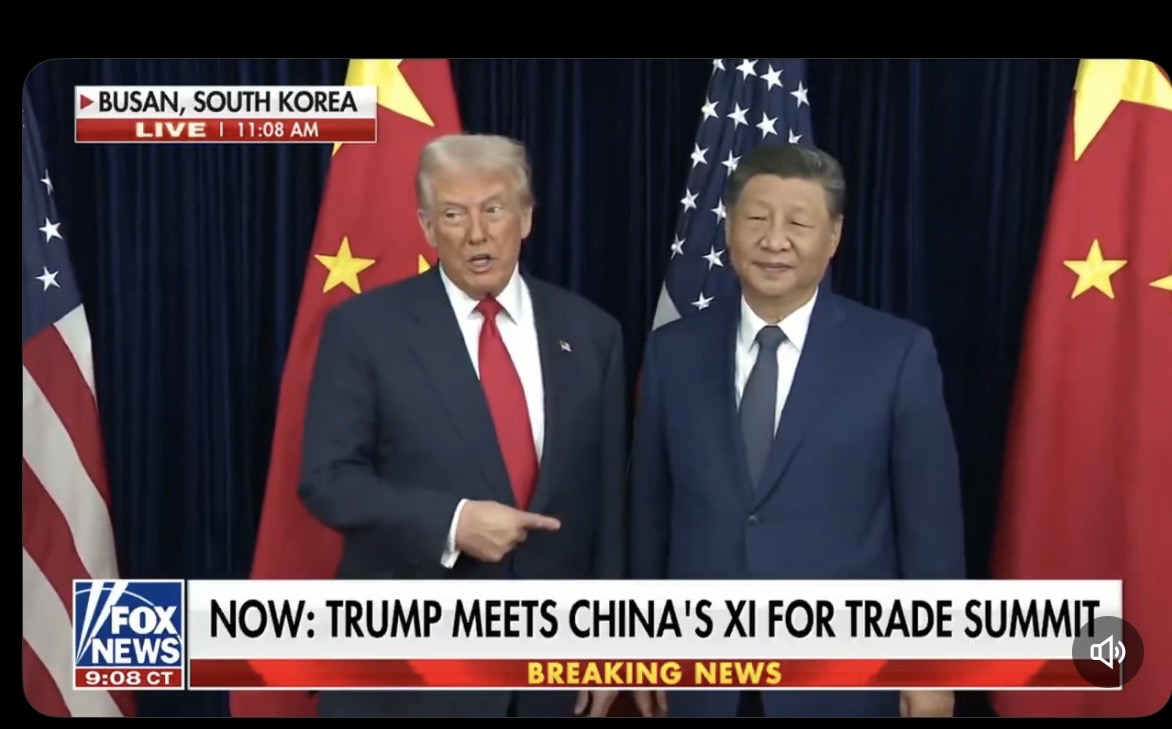
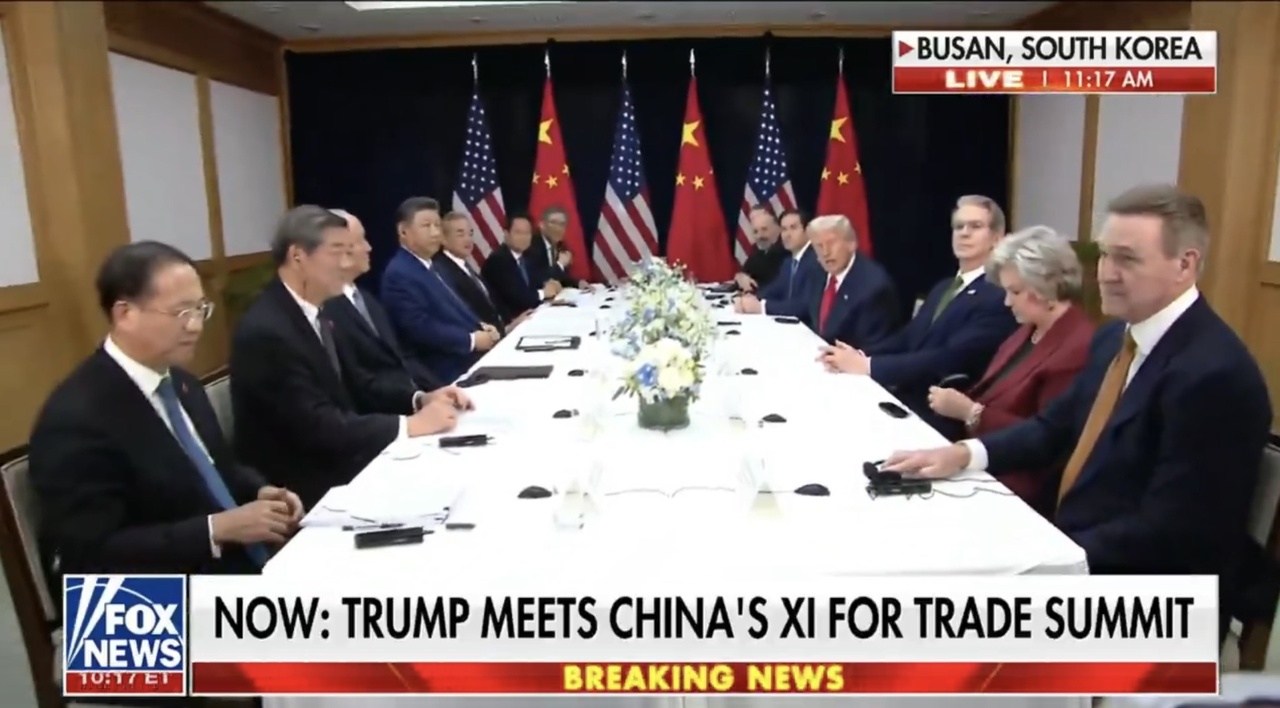
Etf with distribution/payment date 01/04/07/10
Hello everyone,
I currently have the following Etf with distribution in the same distribution. Behind the payout months
$IWLE (+0,23 %) for 01/04/07/10
$HMWO (+0,06 %) for 02/05/08/11
$SPXD (+0,23 %) for 03/06/09/12
That would be about 66%World and 33%sp500 index.
The distribution is extra because 1. I like the cash flow and 2. I want to utilize the allowance.
As soon as 1000eur are utilized at some point, I will add in tesaurierende.
Now my question...do you know an alternative to the hedge for 01/04/07/10?
Thank you very much :-)
Regards
Sven
November distribution HSBC MSCI World
Moin Moin you philistines,
for the $HMWO (+0,06 %) the fourth and last distribution this year has been scheduled for 24.11.20205 - ex-date is 03.11.2025 - and is at $0.1265
Facts on the table:
- Compared to last year's fourth payment (0.1233$), this is an increase of 2.60%.
- The payout for 2025 thus increased by 3.18% to $0.554 compared to 2024
- After 2020 with a dividend growth of -13.49%, 2025 has the smallest change compared to the previous year with the above-mentioned +3.18%
- Since the first dividend in 2015, this has increased by an average of 5.88% - if 2020 is excluded, it would be +8.03%
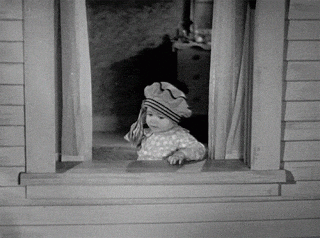
Error? What? Really, please. 🤷🏼♀️
- 50 shares $VWRL (+0,32 %) bought back cheaper 😎 The rest will follow in the next few days/weeks
- $EQQQ (+0,41 %) I'll wait a little longer, or maybe I'll give priority to financing 🥲
- $1810 (+2,26 %) and $ARM (+0,66 %) minimally topped up. Buy the dip
- $VUSA (+0,23 %) - $HMWO (+0,06 %) - $BTC (+1,9 %) one off-plan purchase each. Buy & Hold
- My $AMD (+0,85 %) short has also performed well. My other warrants have very large KO distances and are held.
(of course I'm luckier than I am smart, but on the other hand it's crazy to believe that the stock market only ever goes in one direction 🤭)
-------------------------------------------------------------------------------------------------------
It looks like I've made a terrible mistake 🤓
At the beginning of October, I sold two of my ETFs, the $VWRL (+0,32 %) and the $EQQQ (+0,41 %) .
I was convinced that we would see at least a short-term but significant correction in October.
And since I was planning to transfer these ETFs from Trade Republic to Flatex anyway, I thought: Sell now, pick up cheaper later 🤪
Since then, of course, the market has rallied. Fortunately, I still have the $HMWO (+0,06 %) and $VUSA (+0,23 %) and my shares.
My original plan was to sell, wait out the crash and then get back in. Due to the broker's fee model and position size, I would have bought back the NASDAQ in one transaction as a savings plan, the savings plan is still active on October 23 and I could have bought back the All World flexibly in large tranches as there are no order fees at all.
At the moment, however, it looks as if the plan won't work out 🥲
The total amount is €20,000. I transferred € 9999 of this to my account without any problems (no proof, no delay, approx. 24 hours) and € 7500 of this to Flatex for the QQQ on the 23rd .
The rest is still with Trade Republic and is even earning a little interest there. I hope I don't have to wait until November to get the rest of the money out of Trade Republic without any problems...
Now I see the following options:
1) Put everything into All World right away.
I can buy the NASDAQ later with fresh capital if there is another setback.
2) Pay off the last financing.
I have around €10,000 outstanding, with a monthly installment of €238.
Apart from that, I am debt-free.
The interest rate is around 6-7%, plus hidden costs such as account management fees and endowment insurance.
So it would be worth considering closing the loan completely, but that would leave very little capital for ETFs.
3) Stick to the original plan
Uptober isn't over yet 🥲
4) All in $NVDA (-0,35 %) 🤣
5) Gradually in with a savings plan.
6) Or will the seasonal setbacks only occur from January/spring 2026?
Which options do you think make sense? What are your thoughts?
It looks like I've made a terrible mistake 🤓
At the beginning of October, I sold two of my ETFs, the $VWRL (+0,32 %) and the $EQQQ (+0,41 %) .
I was convinced that we would see at least a short-term but significant correction in October.
And since I was planning to transfer these ETFs from Trade Republic to Flatex anyway, I thought: Sell now, pick up cheaper later 🤪
Since then, of course, the market has rallied. Fortunately, I still have the $HMWO (+0,06 %) and $VUSA (+0,23 %) and my shares.
My original plan was to sell, wait out the crash and then get back in. Due to the broker's fee model and position size, I would have bought back the NASDAQ in one transaction as a savings plan, the savings plan is still active on October 23 and I could have bought back the All World flexibly in large tranches as there are no order fees at all.
At the moment, however, it looks as if the plan won't work out 🥲
The total amount is €20,000. I transferred € 9999 of this to my account without any problems (no proof, no delay, approx. 24 hours) and € 7500 of this to Flatex for the QQQ on the 23rd .
The rest is still with Trade Republic and is even earning a little interest there. I hope I don't have to wait until November to get the rest of the money out of Trade Republic without any problems...
Now I see the following options:
1) Put everything into All World right away.
I can buy the NASDAQ later with fresh capital if there is another setback.
2) Pay off the last financing.
I have around €10,000 outstanding, with a monthly installment of €238.
Apart from that, I am debt-free.
The interest rate is around 6-7%, plus hidden costs such as account management fees and endowment insurance.
So it would be worth considering closing the loan completely, but that would leave very little capital for ETFs.
3) Stick to the original plan
Uptober isn't over yet 🥲
4) All in $NVDA (-0,35 %) 🤣
5) Gradually in with a savings plan.
6) Or will the seasonal setbacks only occur from January/spring 2026?
Which options do you think make sense? What are your thoughts?
Valores en tendencia
Principales creadores de la semana


